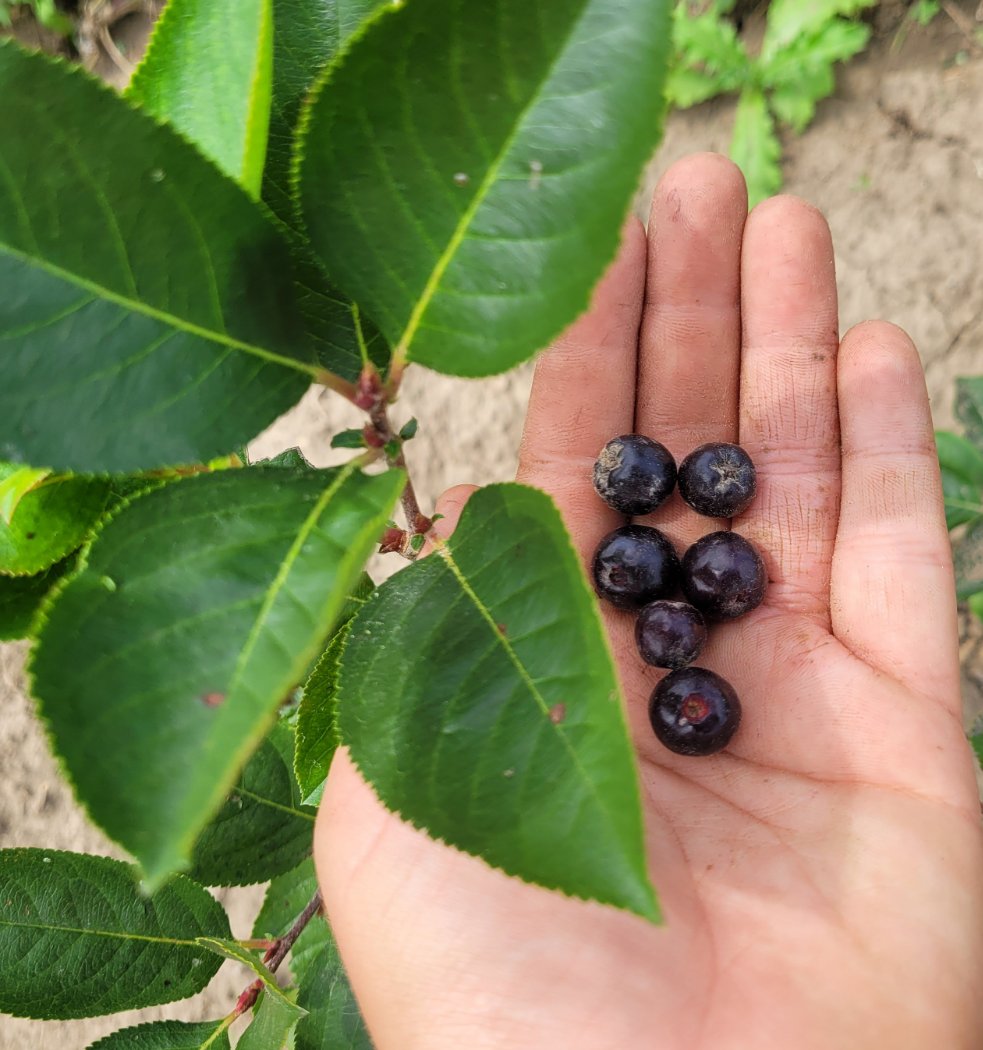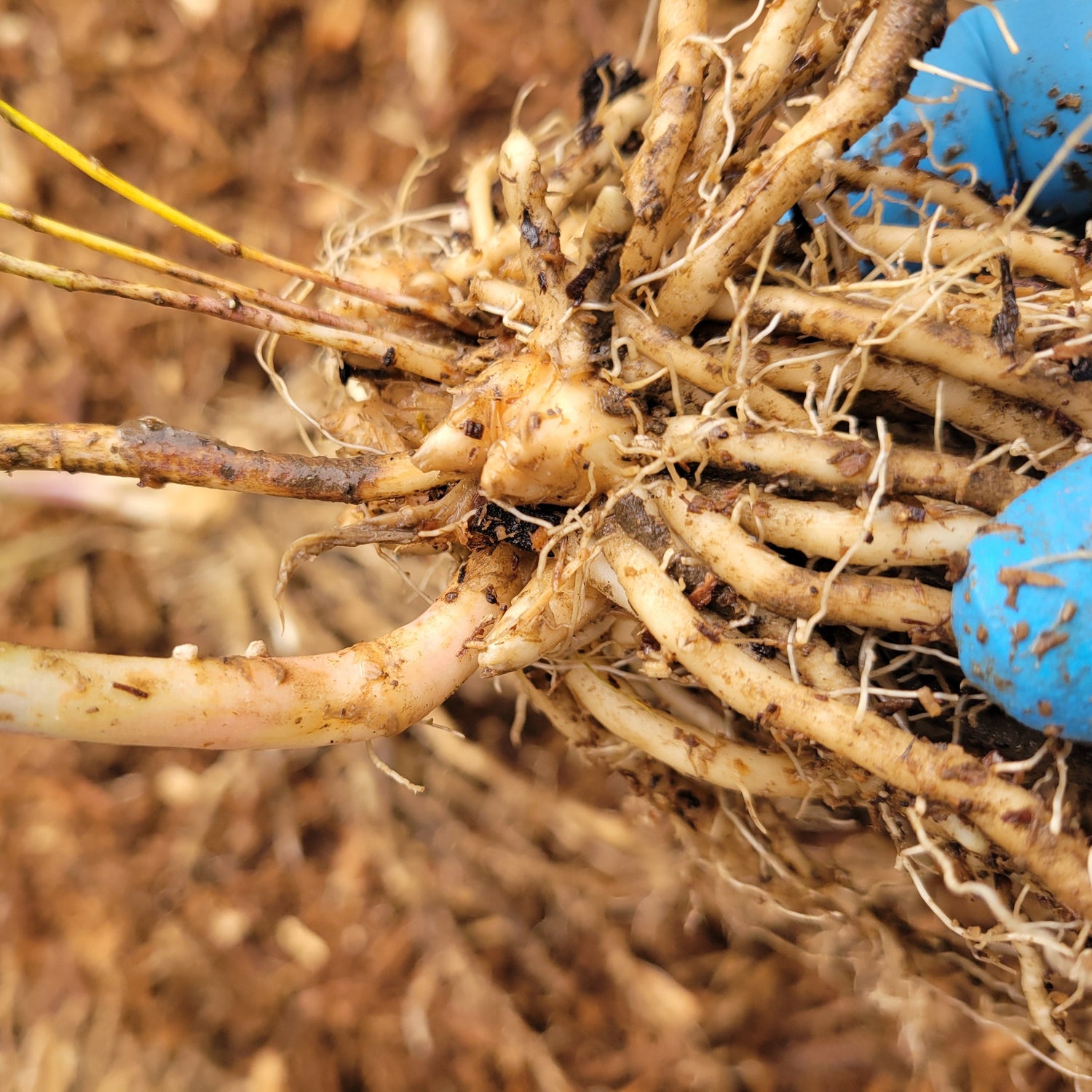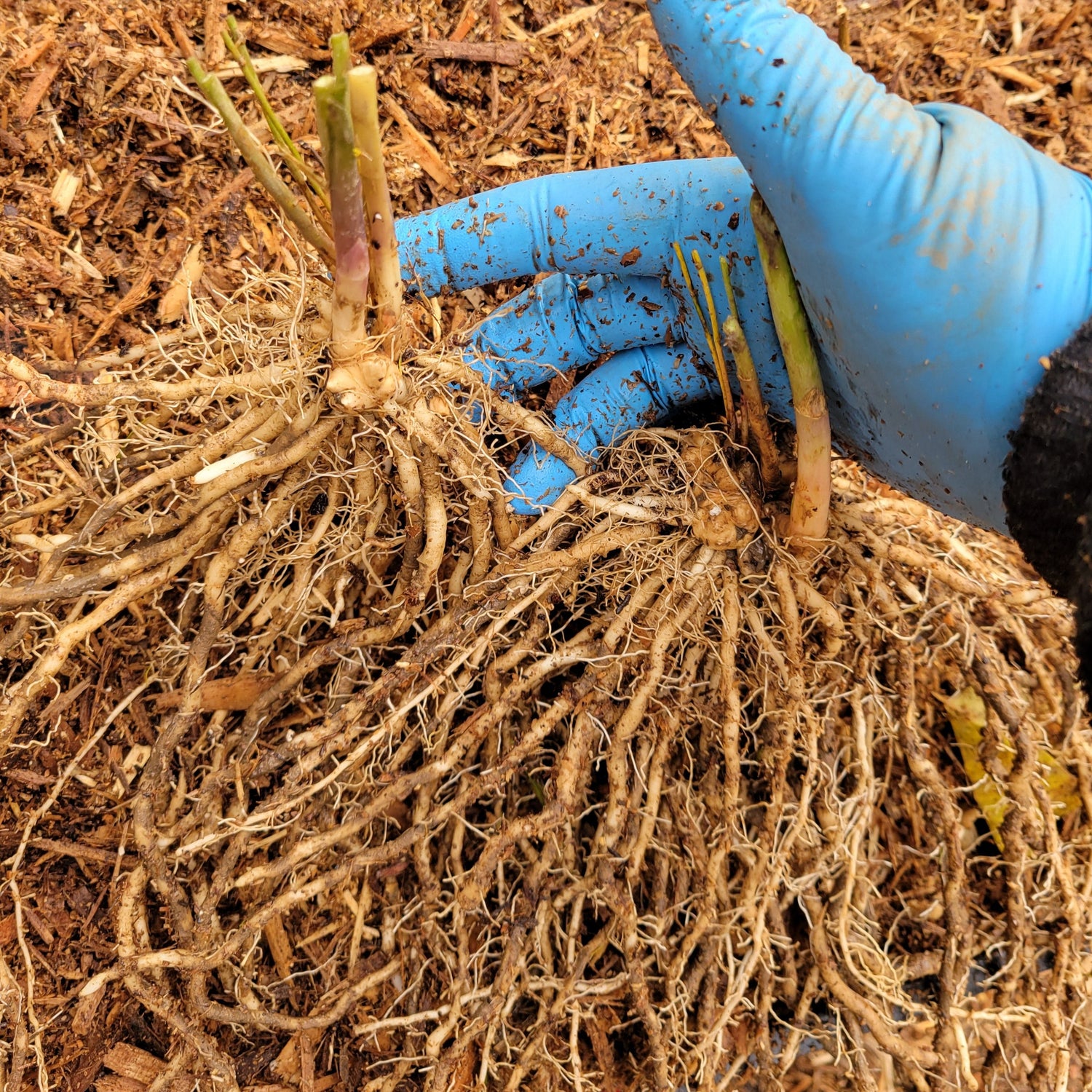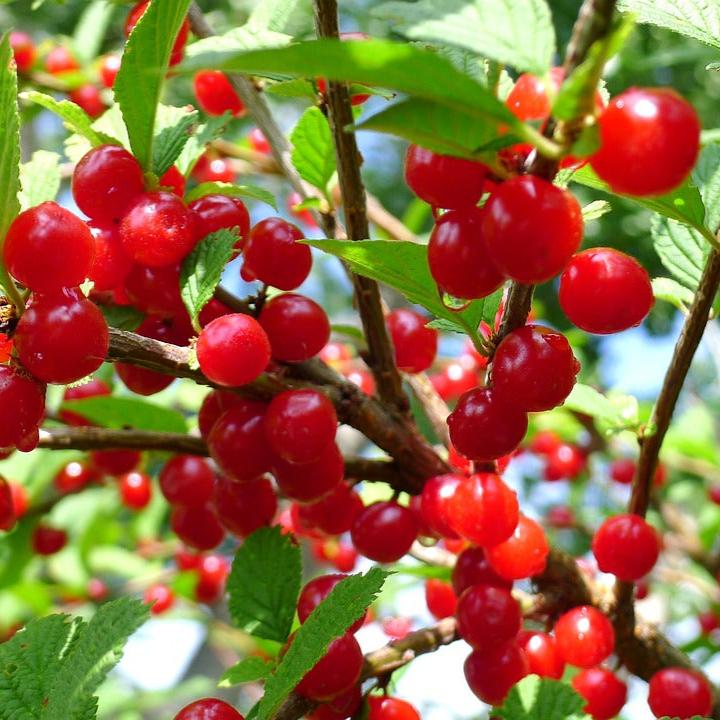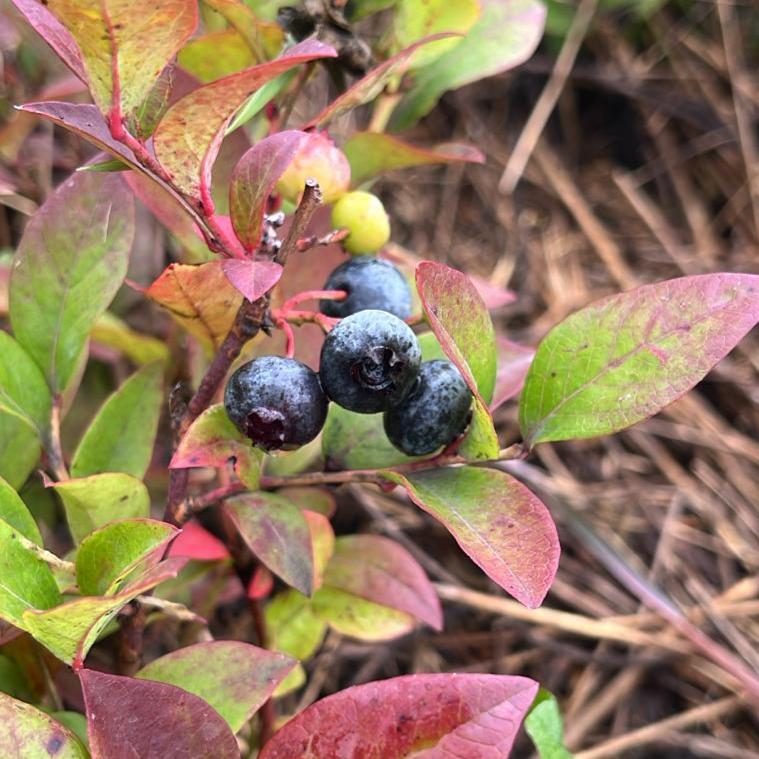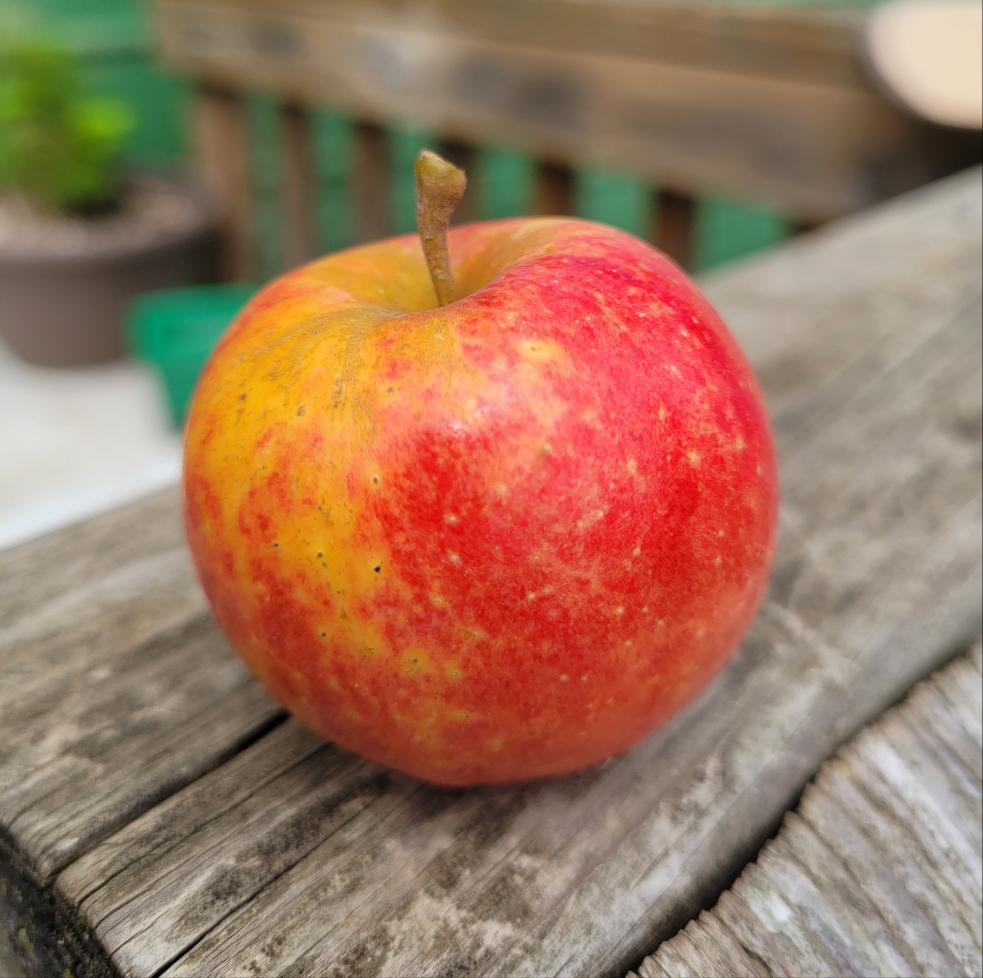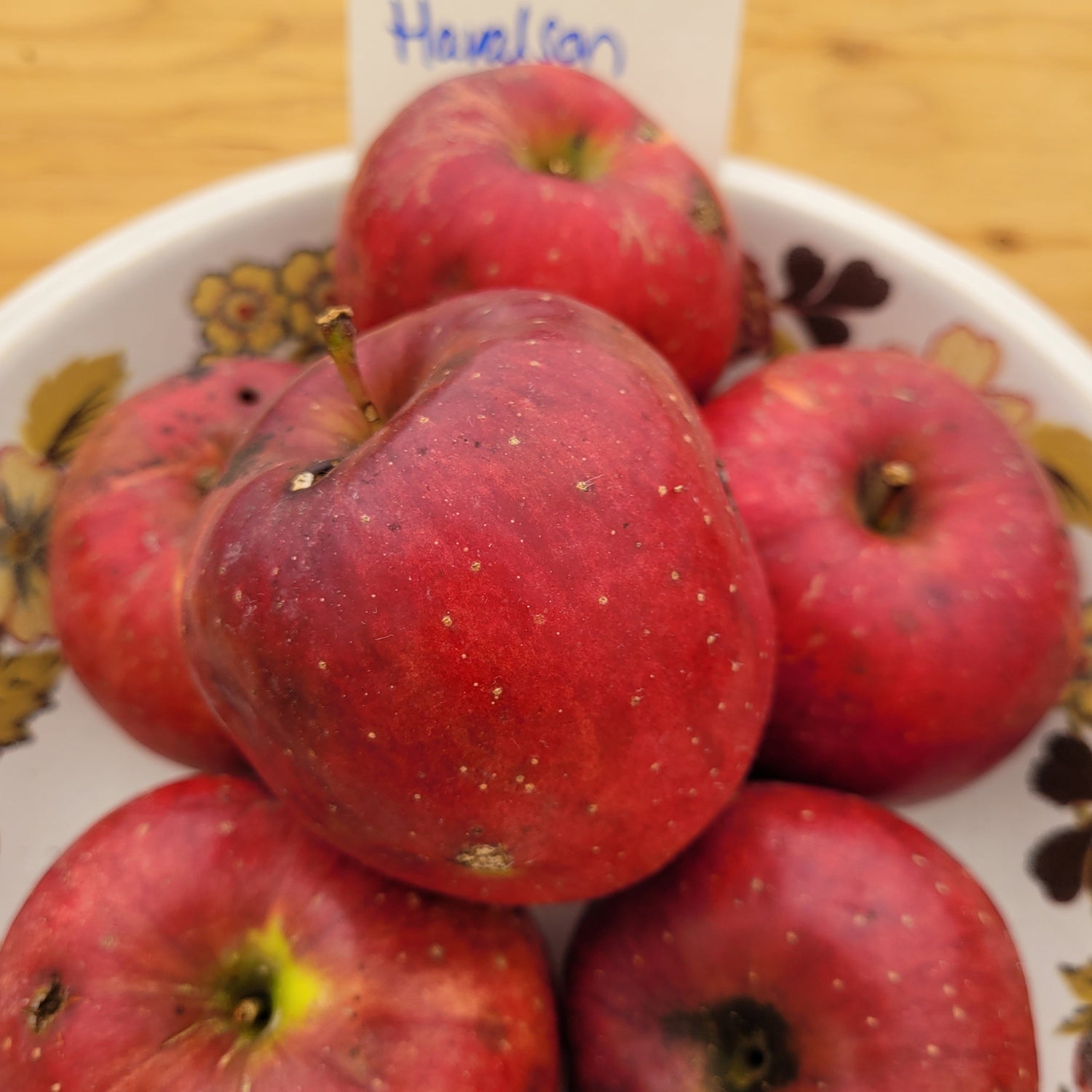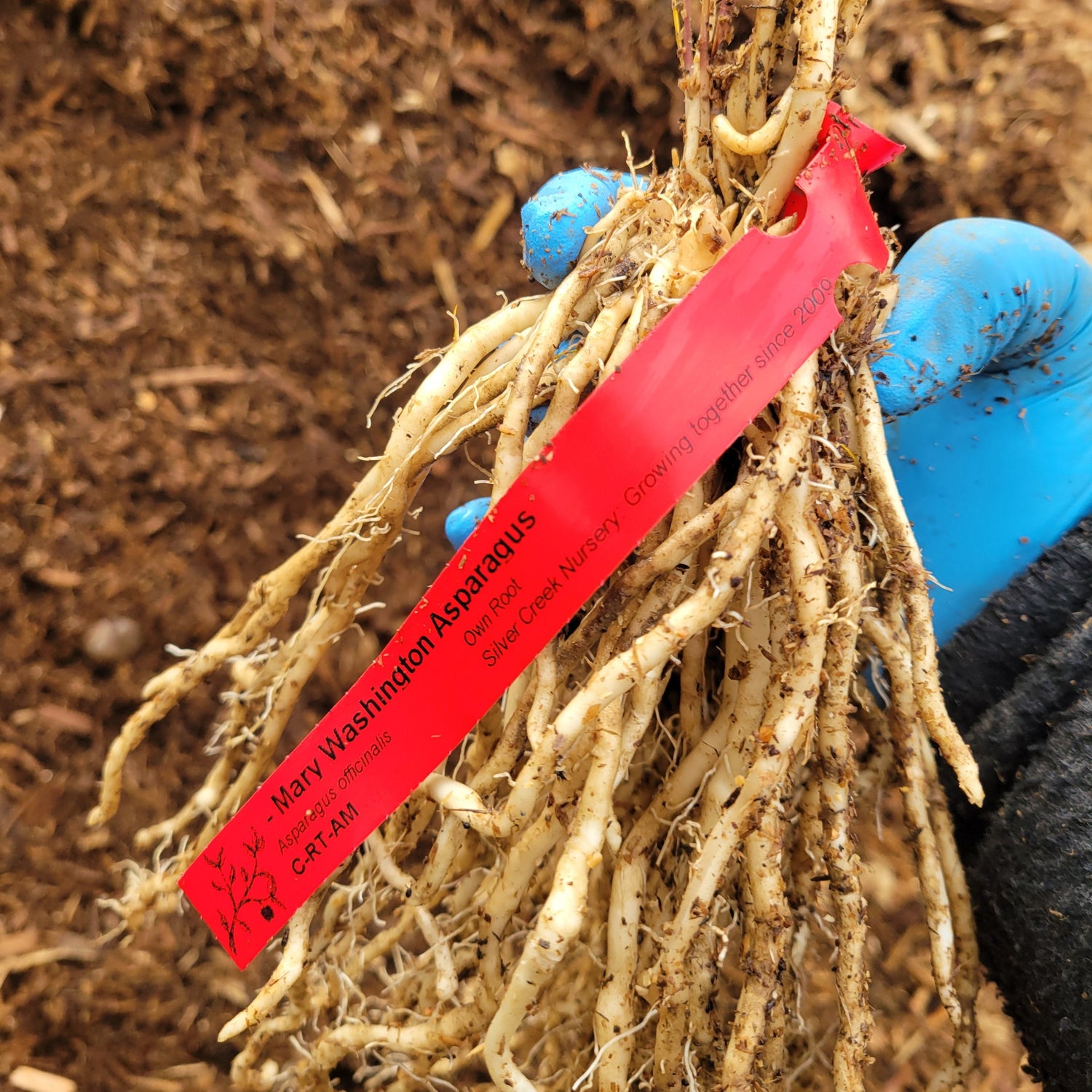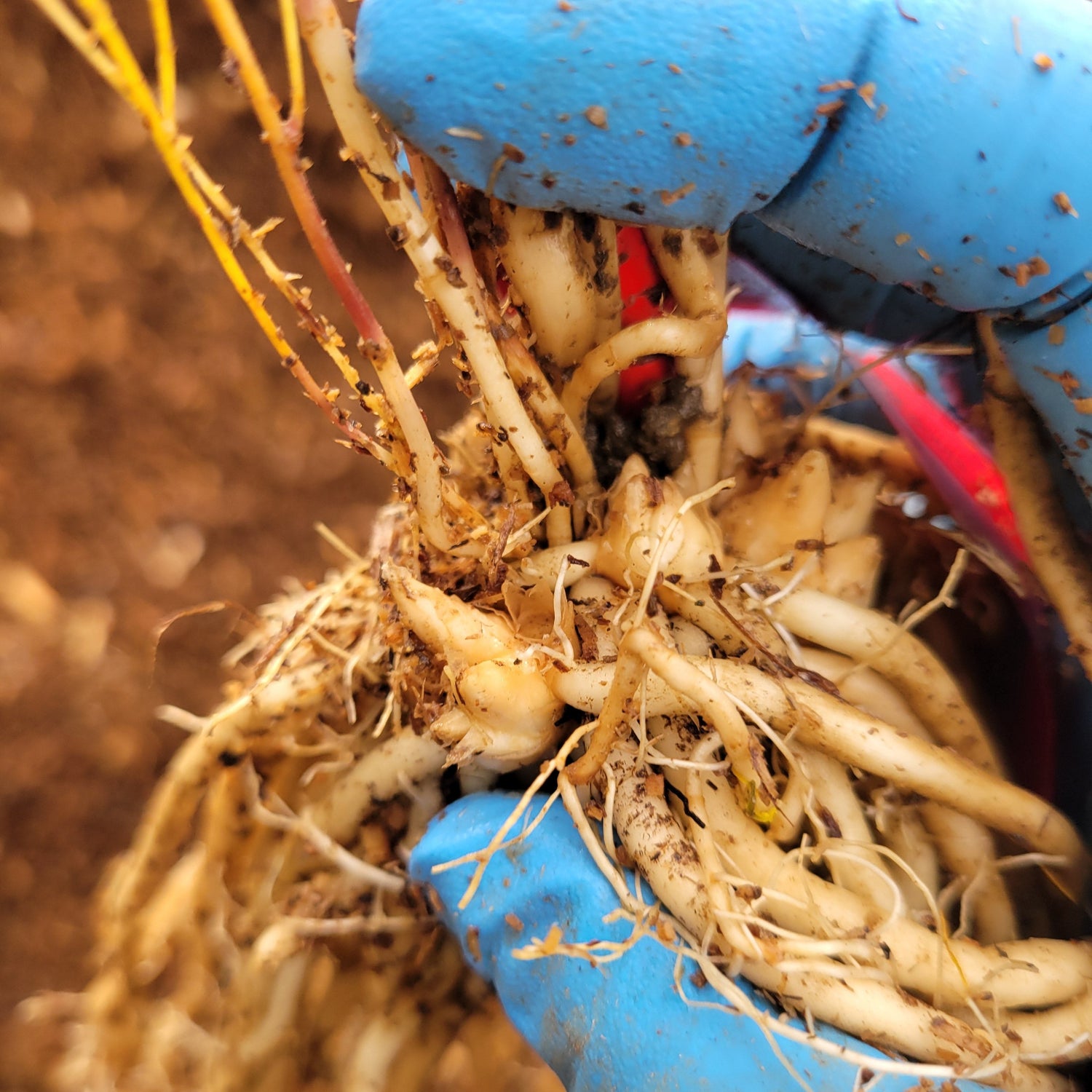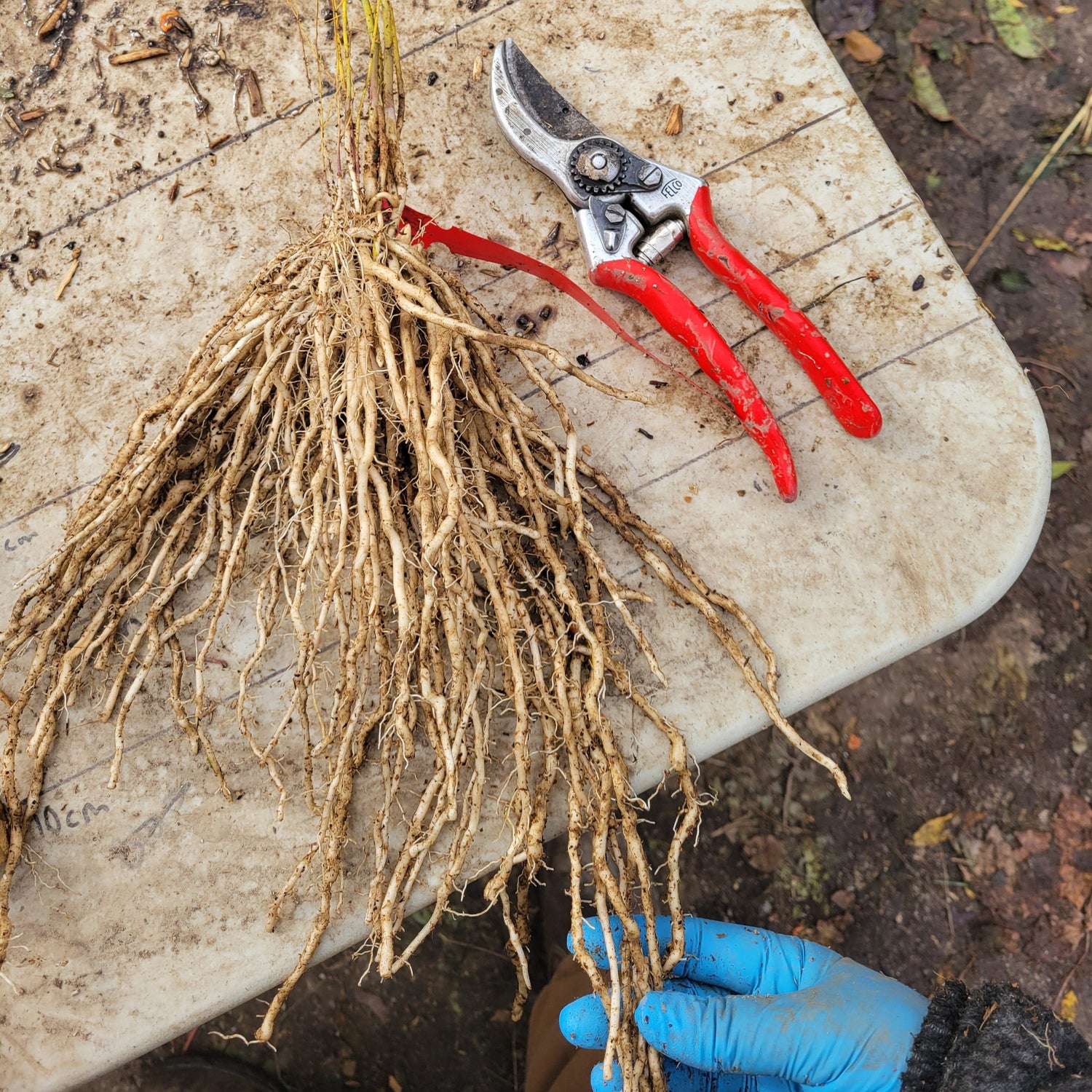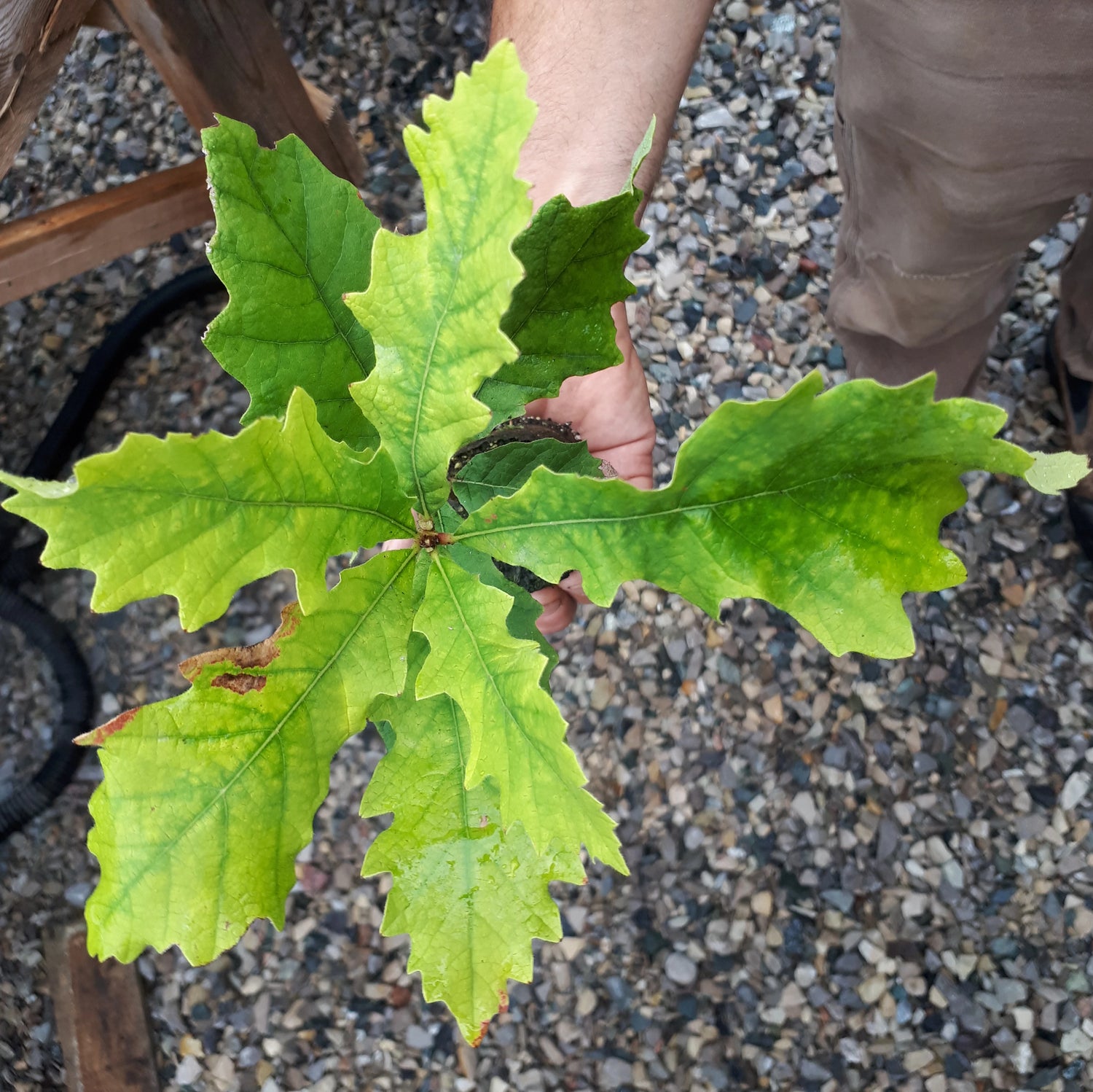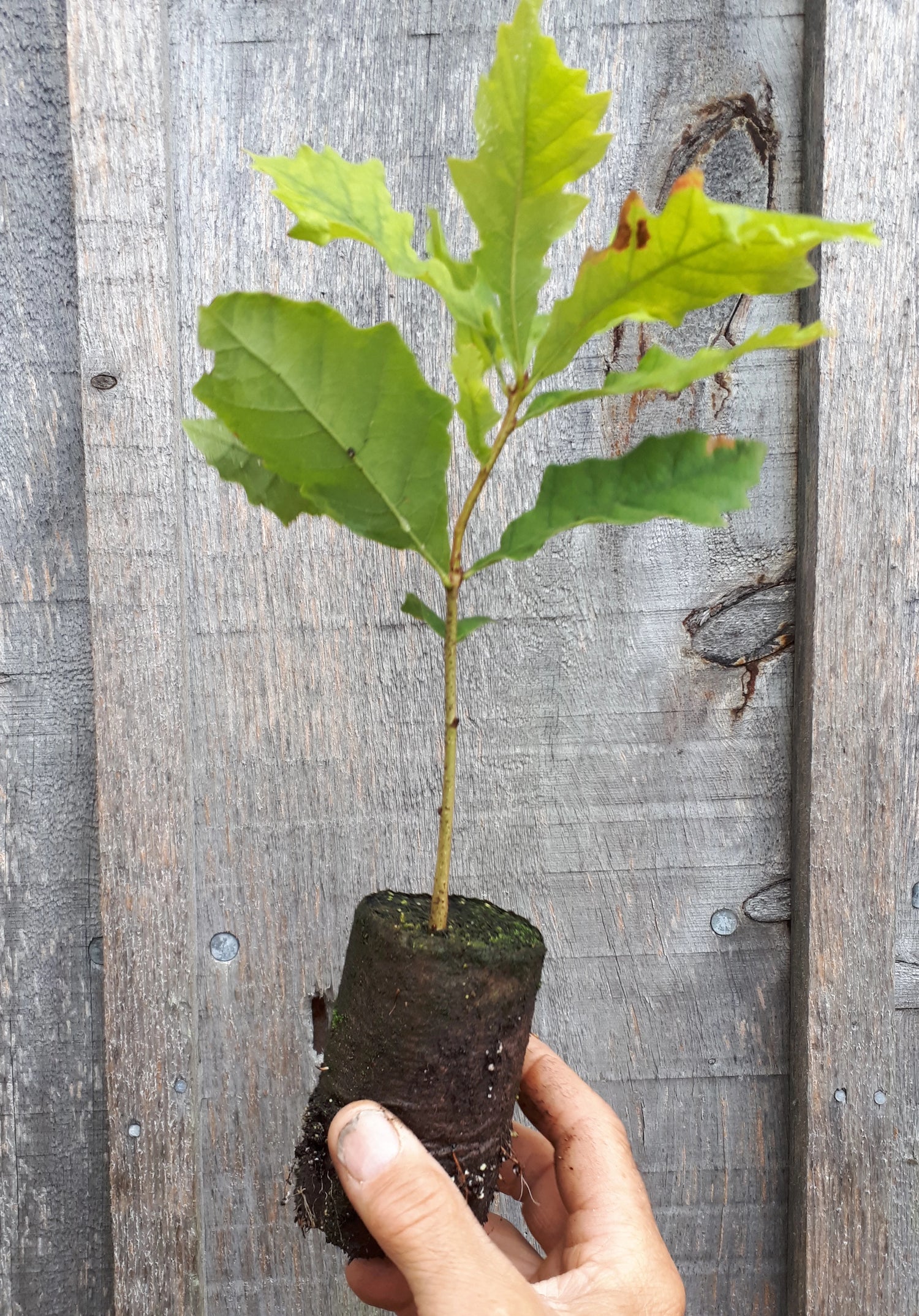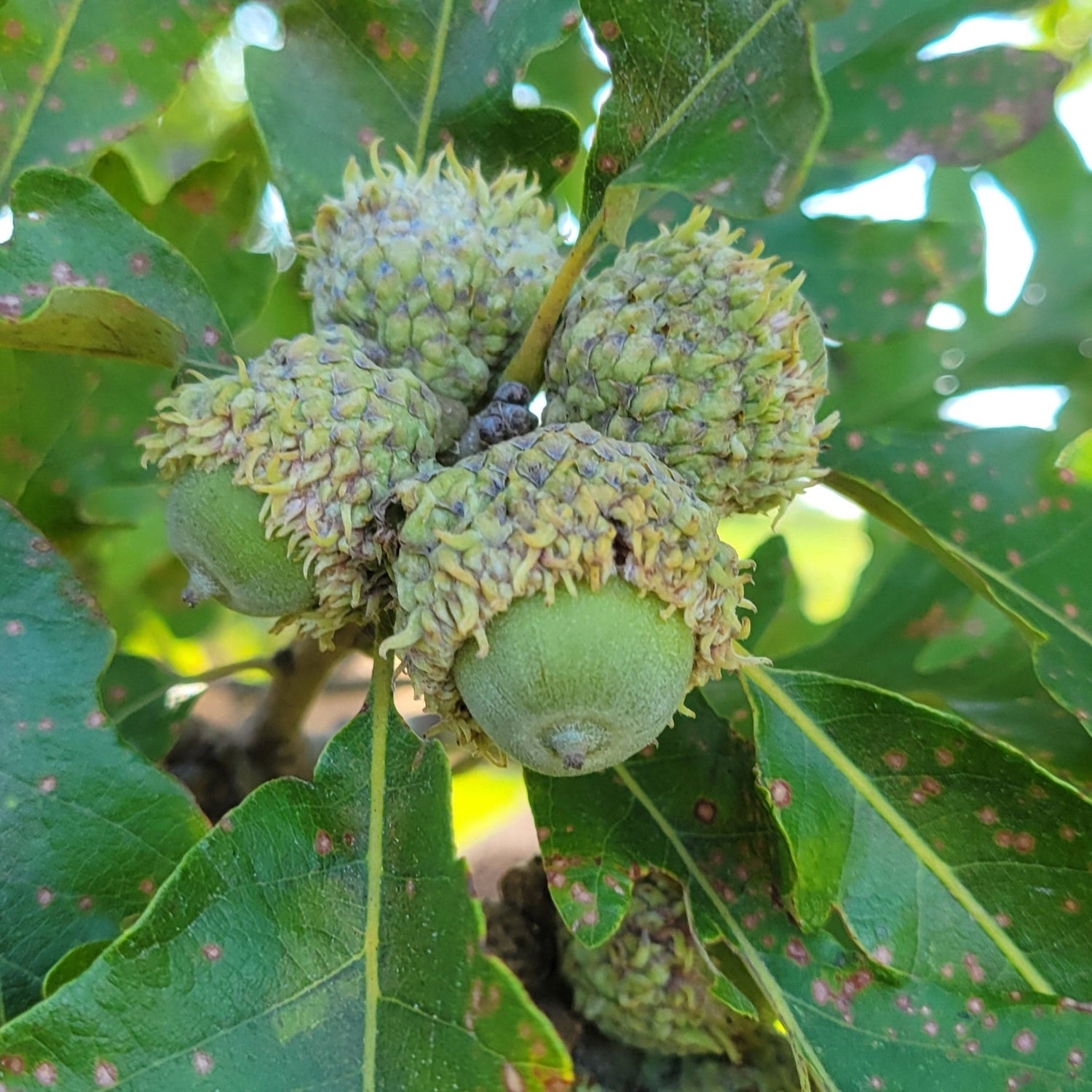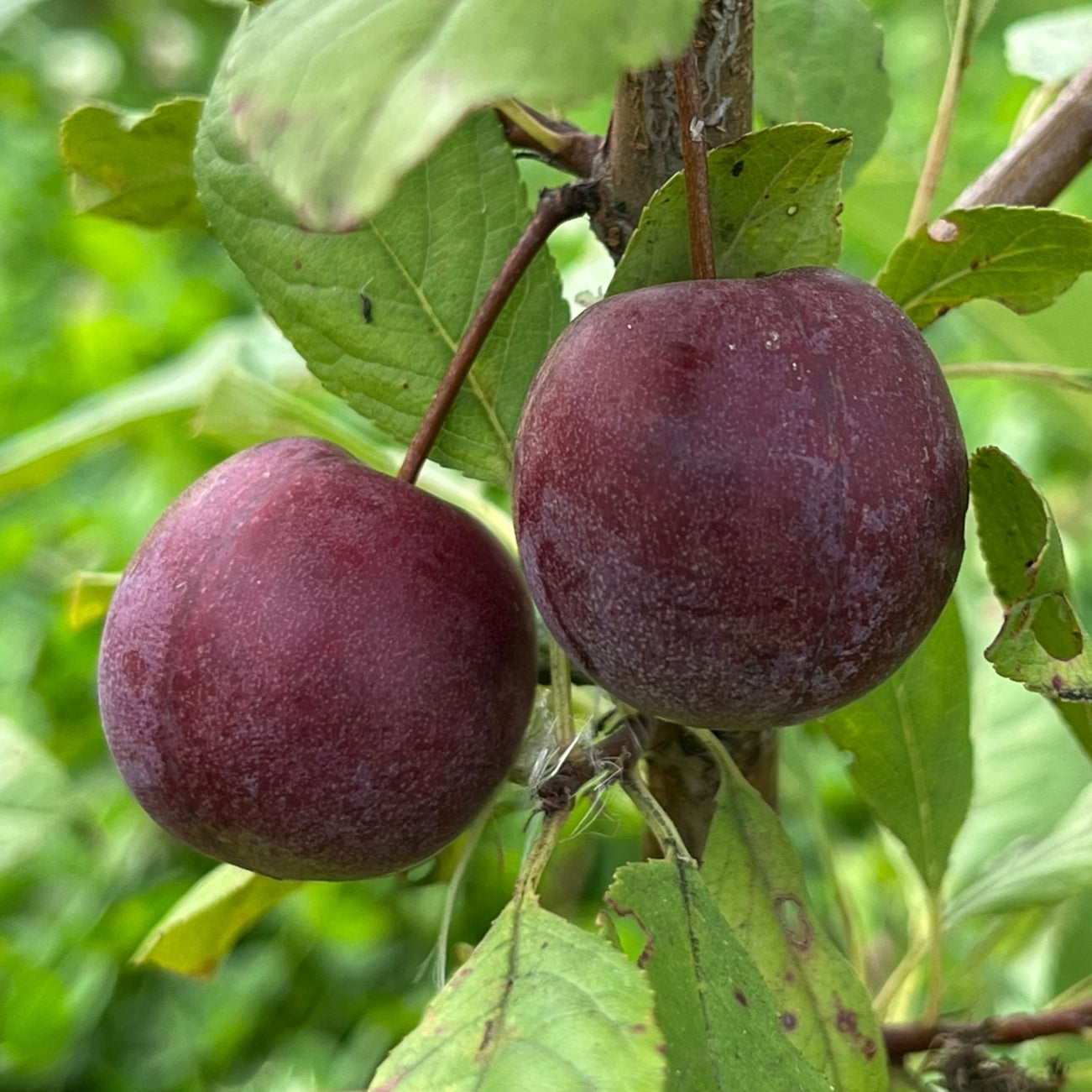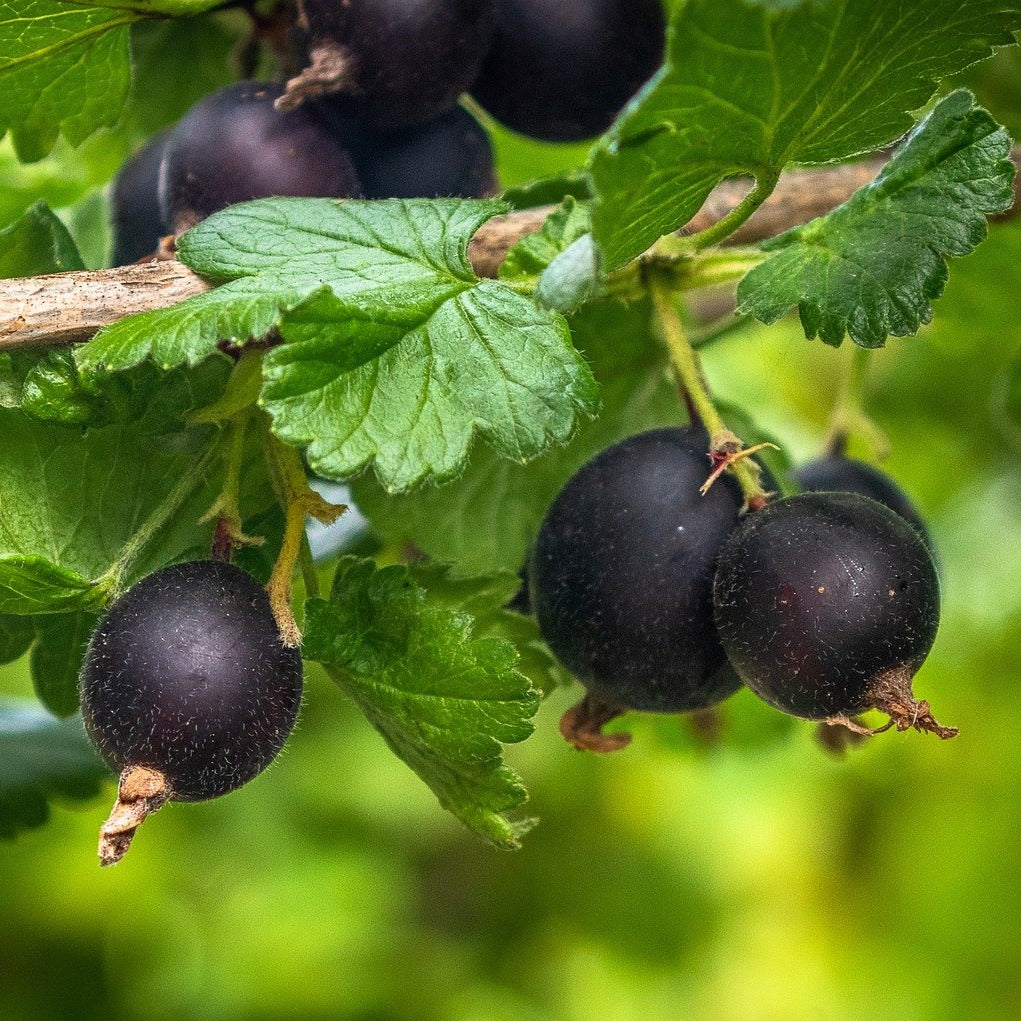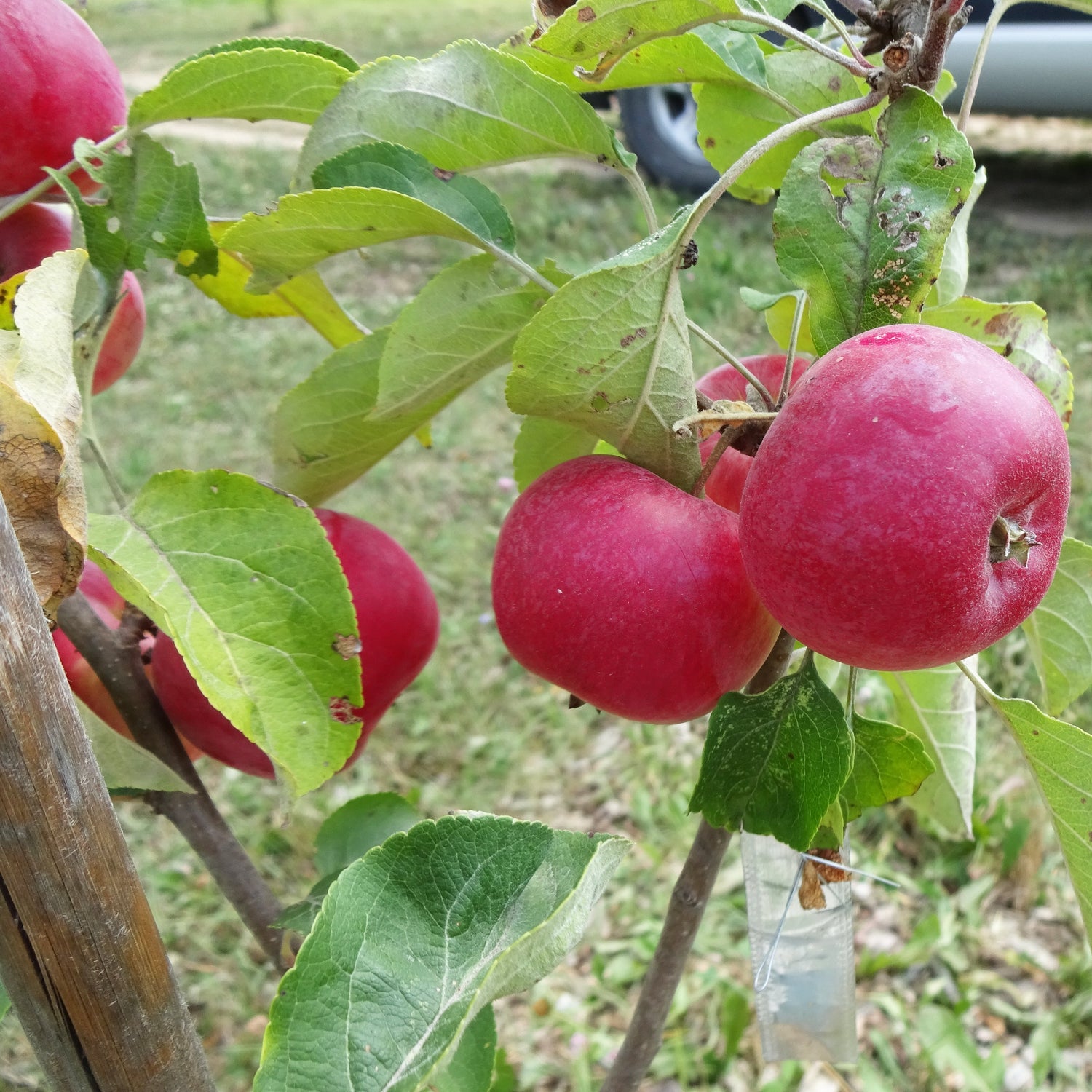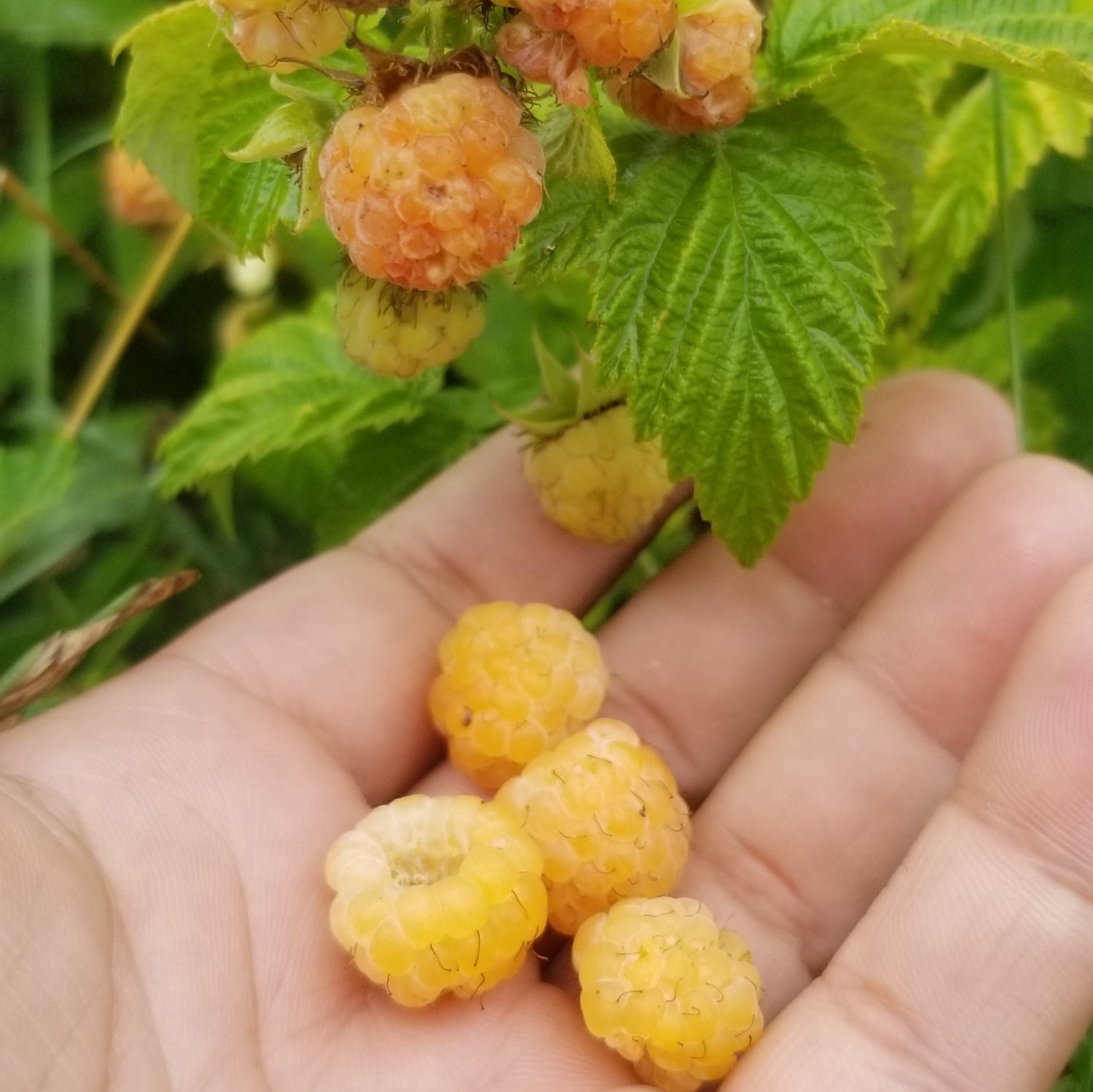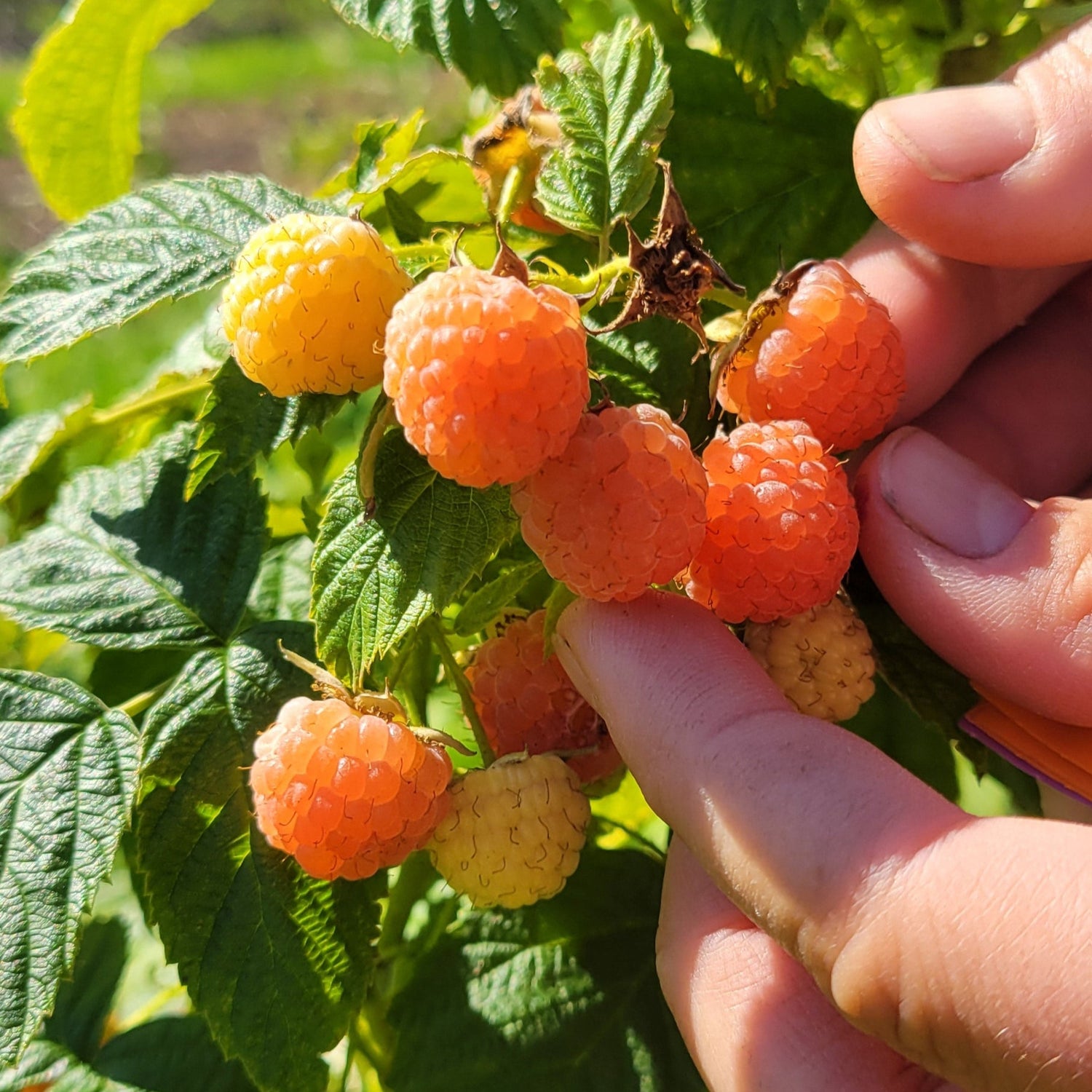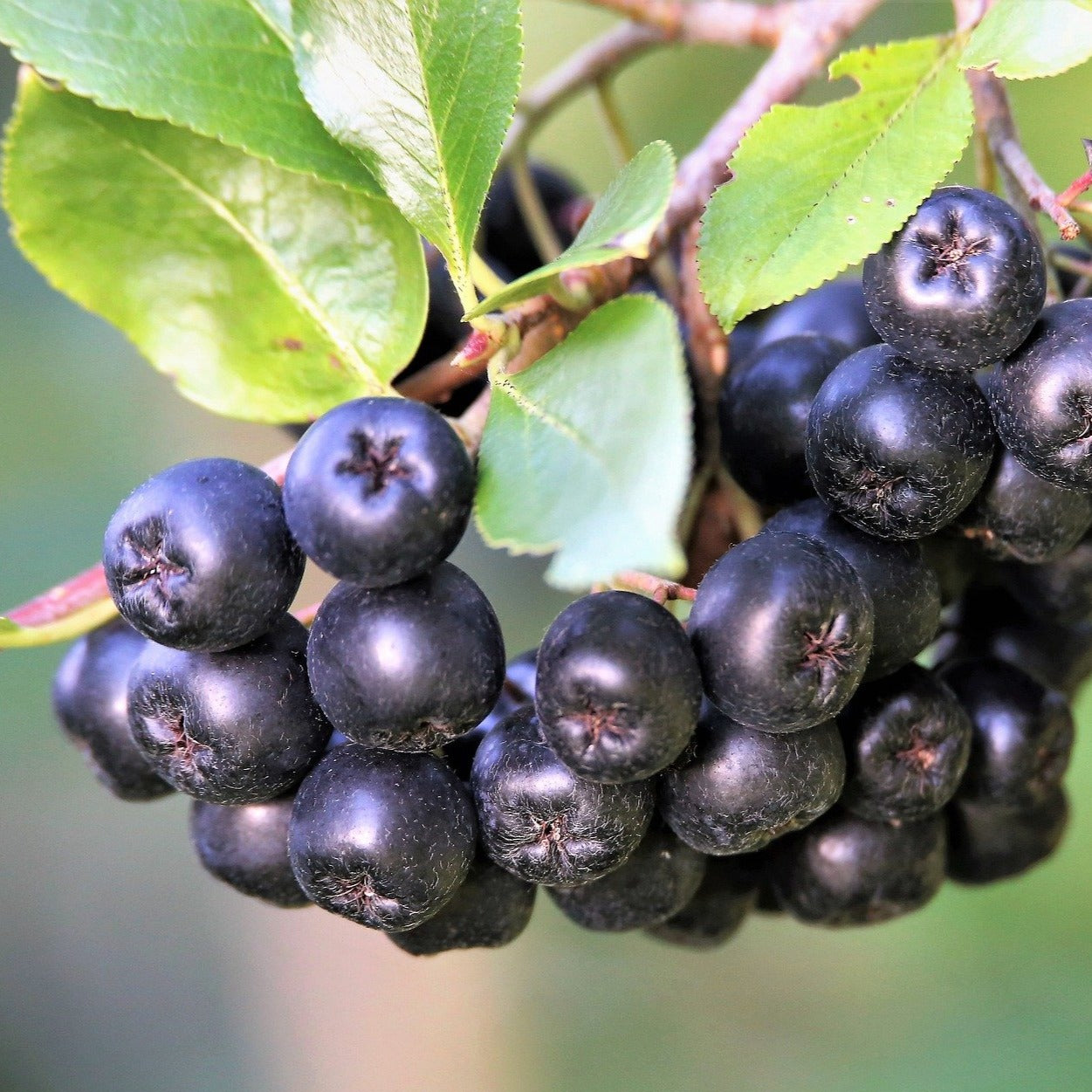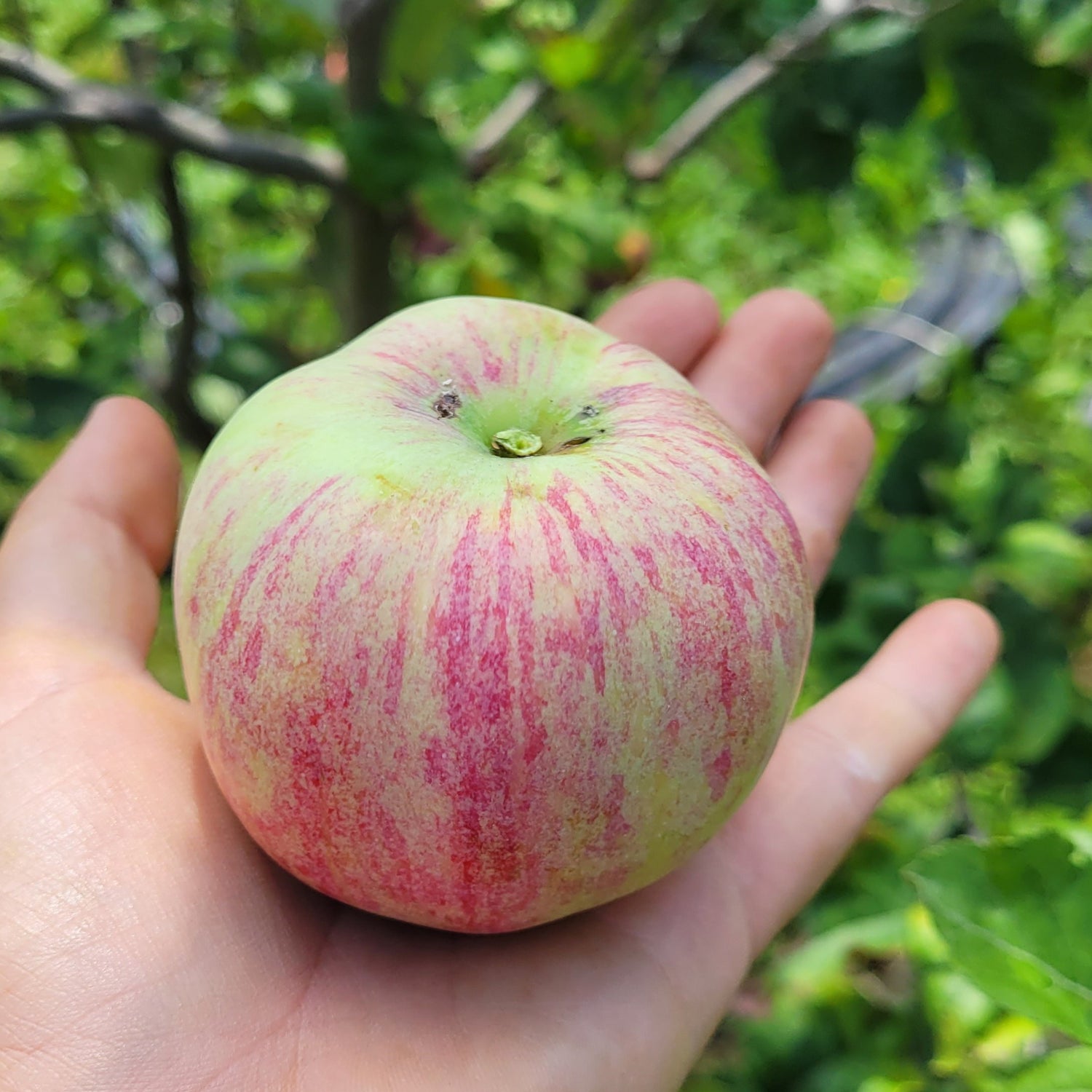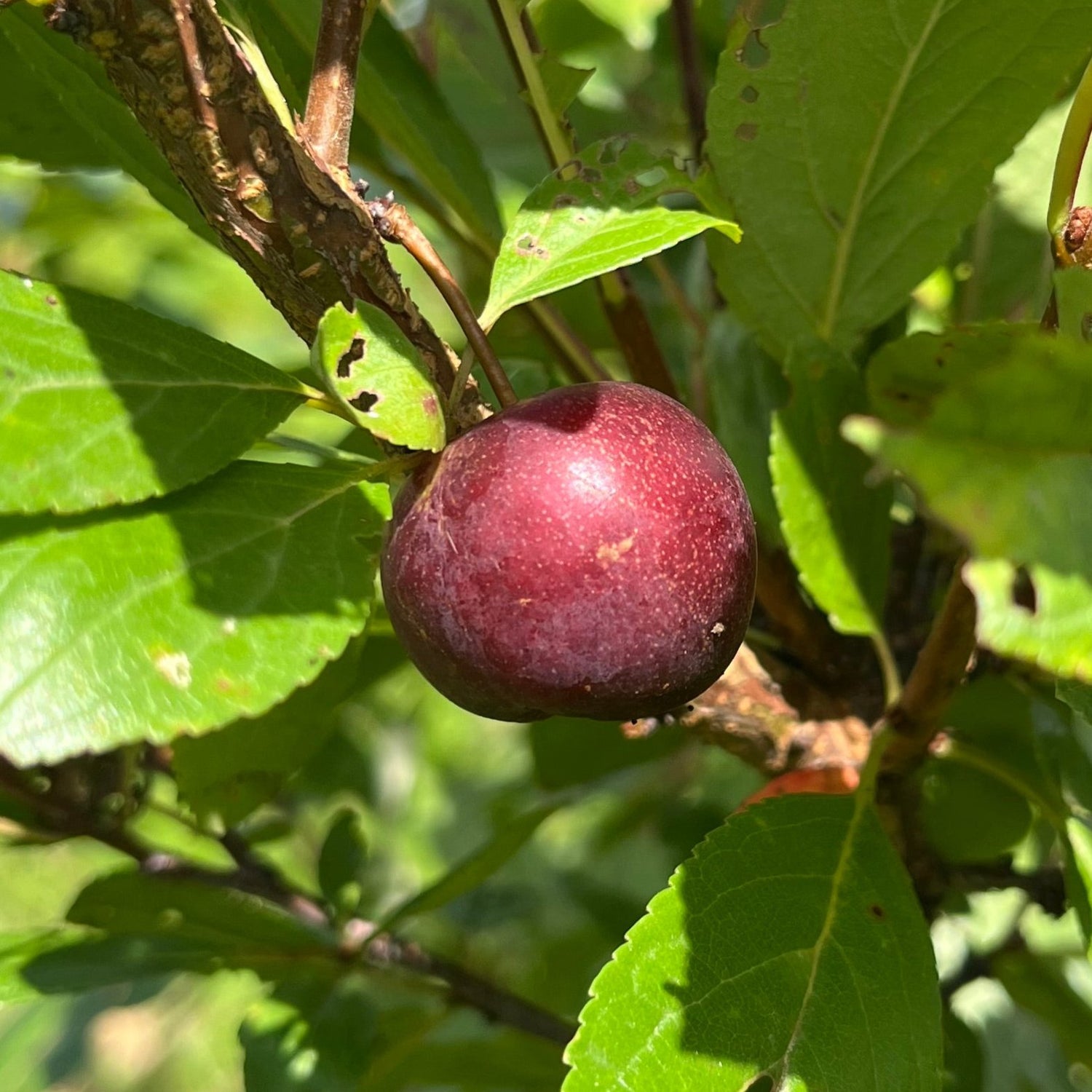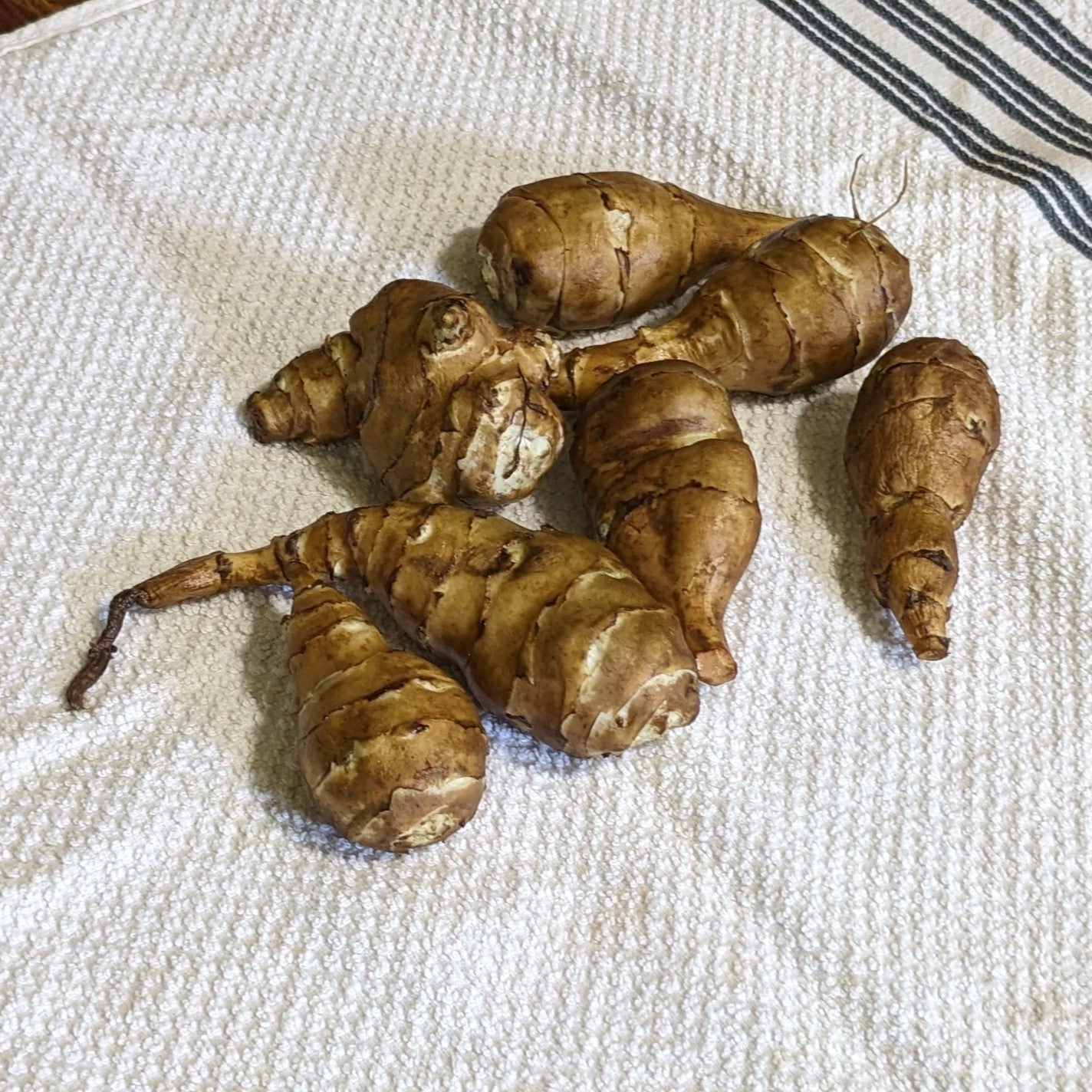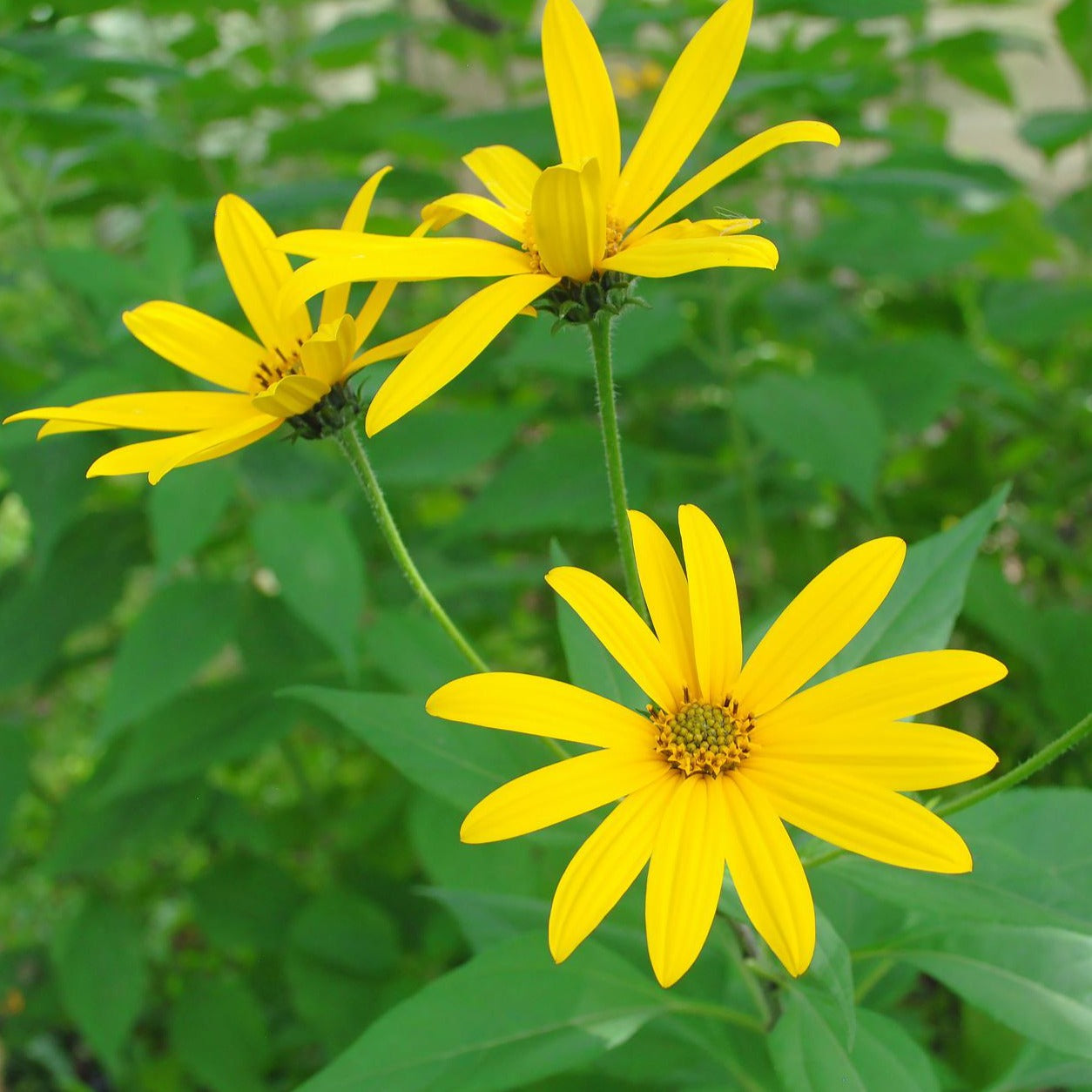All Zone 4 (or hardier) Plants
Sort by:
232 products
232 products
Species: Aronia melanocarpa
History: McKenzie was created by the USDA who, in 1976, planted several seedlings of the variety to evaluate its performance. It was named 'McKenzie' in honour of its first planting site in North Dakota, possibly named after McKenzie County specifically. The variety was officially released in 2008.
Why We Grow It: McKenzie boasts vigorous growth and good production, reliably producing firm blue-black fruit that is tart with an earthy taste. The berry clusters are easy to pick and have a wide range of uses! While the berries ripen in August, they can hang onto the bush for a couple months and tend to sweeten over time.
Species: Vaccinium corymbosum
History: Patriot was developed by the USDA and Maine Agriculture Experimental Station where it was first bred in 1954. It was selected for its cold hardiness and resistance to root rot. Patriot was released in 1976 and given its name to mark the 200th anniversary of the signing of the Declaration of Independence.
Why We Grow It: Patriot produces large berries with excellent flavour that are a bit on the softer side. The fruit ripens early in the season and is great for fresh eating, baking, preserving, and freezing! It is more tolerant of the cold and of wet soils than other blueberries and can be grown even in a clay soil.
History: Antonovka was discovered near Kursk, Russia in 1826 and then developed by renowned Russian plant breeder I.V. Michurin. It was released in 1888 and became a popular variety in Russia, Poland, and Belarus due to its good flavour and quality for cooking/baking. In Russia, Antonovka was given the name 'The People's Apple' and in 2008 a monument to it was unveiled in Kursk. Although this hardy variety is less popular outside of its homeland, it has been commonly used as rootstock due to its ability to grow a strong, deep root system that makes it hardier and more drought tolerant.
Why We Grow It: This tree produces a refreshing, juicy, tart yellow apple that cooks down well. It is also quite cold hardy which is a great feature in our Canadian environment.
History: Maiden's Blush was first described in New Jersey in 1817 although it had already been popular in Philadelphia markets for some time. It likely originated around New Jersey in the late 1700s. Maiden's Blush continued to be commonly grown in the southern US through the early 1800s.
Why We Grow It: Maiden's Blush's uniqueness is still worthy of attention today, its flavour being an interesting mix of citrus-like acidity and sweetness that stand out among other apples. While it is good for fresh eating, particularly after a few weeks off the tree, it is most well known for cooking, baking, and drying due to its non-browning qualities.
Species: Asparagus officinalis
History: The parent of these seedlings, Precoce d'Argenteuil (translated from French as 'early Argenteuil'), is an heirloom French variety that has been grown since either the 1700s or 1800s depending on the source. It was first listed in 1885 and is a selection from the Giant Dutch Purple variety of asparagus, along with the middle and late Argenteuil varieties which were all likely named after the commune in Paris. It is still commonly used in French dishes to this day. The variety is also sometimes called White Gold if grown without exposure to light, causing the plants to remain white. These seedlings may vary from their parents but should bear similar traits!
Why We Grow It: We love offering seedlings as a way to add some diversity to the plants being grown! The parent variety Precoce d'Argenteuil may not be as productive as modern varieties, but its excellent flavour more than makes up for it! Living up to its name, this variety produces thick shoots quite early in the season as well.
Species: Prunus tomentosa
History: Nanking cherry is native to parts of China, Tibet, Korea, and Mongolia, and possibly northern India. It has long been cultivated in Asia for its tart fruit which is used in pickling, making wine, juice, and jam, and as an ornamental plant. It was introduced to Britain in 1870 and the US in 1892 where it is also planted in hedgerows as a windbreak. Breeding programs in the US, Canada, and Russia began in the 1920s to make the fruit more palatable fresh but by the 1940s interest had unfortunately waned.
Why We Grow It: Although more closely related to plums than cherries, Nanking cherry is great for a variety of uses including wine, juice, jam, and as an ornamental plant thanks to their attractive pinkish-white blossoms. Some enjoy eating the tart fruit fresh as well and they are also popular with birds and wildlife. Nanking cherries are hardy and tolerant of quite cold weather, making them an excellent option for most parts of Canada.
For the most up-to-date information see Claude Jolicoeur's website here!
History: Douce de Charlevoix (translated from French as 'sweet Charlevoix') was discovered by Claude Jolicoeur in a Quebecois village in the county of Charlevoix in the 1990s. He has since dubbed it a 'first class early cider apple' and in 2015 a cider blend using 40% Douce de Charlevoix won a bronze medal at the GLINTCAP competition.
Why We Grow It: This apple is quite attractive with orange-red stripes across green skin and makes an excellent juice with a notable bitter taste. In general this apple has medium tannins, some sweetness, and very little acidity. The tree itself is also quite vigorous and hardy.
Species: Vaccinium corymbosum
History: Elliott originated in 1947 when Dr. George Darrow of the USDA first bred it. Elliott, and the other blueberries Dr. Darrow bred, were first evaluated by Dr. Arthur Elliott and then by members of the USDA such as Arlen Draper who has bred numerous blueberry varieties. It was released in 1973, over 25 years after the it was originally grown. Elliott was selected for the good quality of its fruit and its exceptionally late ripening time, making it a great variety for extending the blueberry season. It was named Elliott to honour Dr. Elliott's contributions to blueberry breeding efforts.
Why We Grow It: Elliott produces large berries with a mild sweet flavour late in the season. They are great for fresh eating, cooking, baking, and preserving! The bush is very productive and the firm fruit stores well. For those who want to enjoy fresh blueberries for as long as possible, Elliott is an excellent choice due to its very late ripening time!
History: This English cider apple originated in and was named after Rodney Stoke, a small village in Somerset, England. It was discovered around 1920 and has been popular in England since.
Why We Grow It: Stoke Red produces a great bittersharp juice that is well-regarded for cider making. As an added bonus, it is a heavy cropper and resistant to scab.
History: Norkent was bred as a cross between Haralson and Rescue at the Morden Research Station. It was one of tens of thousands of seedlings sent across the prairies as part of the Prairie Fruit Breeding Cooperative initiative by Agriculture and Agri-Food Canada in the 1960s. It was planted at the University of Alberta before being moved again to a backyard in Edmonton once the university ran out of space to it grow.
Why We Grow It: This pleasant and aromatic apple is one of the best fresh eating apples for colder climates! The flesh of this red apple is crisp and said to taste like a cross between an apple and pear.
History: Haralson apples were developed at the University of Minnesota in 1922 and named after Charles Haralson who was superintendent of the university's fruit breeding farm. It is one of almost 30 apple varieties the university has developed in its breeding program since it began in 1888.
Why We Grow It: The skin of this variety is striped red with russet dots and the flesh is white, juicy, and of pleasant albeit mild flavour. Haralson boasts excellent cold hardiness and general disease resistance.
Species: Asparagus officinalis
History: The parent of these seedlings, Mary Washington, was introduced by the US Department of Agriculture in California in 1949. Named after George Washington's mother, it is part of the Washington series of asparagus. Fittingly, it remains one of the most popular varieties of asparagus in the US today. These seedlings may vary from their parents but should bear similar traits!
Why We Grow It: We love offering seedlings as a way to add some diversity to the plants being grown! The parent variety Mary Washington is known for producing large quantities of uniform spears in the spring. They have an excellent nutty and buttery flavour and are known for being resistant to rust. They are hardy against both cold and heat.
History: Tremlett's Geneva Bitter (aka Geneva Tremlett's Bitter) come from a tree that was believed to be Tremlett's Bitter, an English cider variety. It was imported to Geneva, New York from England in the 1960s but at some point there was a mix-up and the mistake was only uncovered after many American growers had received scions from the erroneous tree.
Why We Grow It: Although this isn't the traditional bittersweet cider apple popular in England, Tremlett's Geneva Bitter still produces a good quality bittershap cider. Some say it is even better than the original!
Species: Quercus macrocarpa or hybrid. Our seeds are collected from trees that may have been cross-pollinated by closely related species so the resulting seedlings may be hybrids.
History: Burr Oaks are native to much of the central United States with populations in Canada stretching from Alberta to New Brunswick. The tree has been planted ornamentally across North America and the durable wood has uses such as flooring and barrels. The acorns, the largest in North America, are a source of food for many animals and indigenous peoples use the bark medicinally. Numerous towns and a book of poetry are named after this tree.
Why We Grow It: The Burr Oak's acorns have slightly less tannins than other oaks, making it the preferred choice for eating. It still requires processing to remove tannins, but once done, the nuts can be toasted, and/or made into flour and used in baking. It is one of the largest oaks in North America, making quite the specimen when full grown.
Species: Prunus pumila var. besseyi (Western sandcherry) x P. salicina (Japanese Plum)
History: Sapa (translated as 'black' from Lakota) was developed at the South Dakota Agricultural Experiment Station in the US by renowned plant breeder N. E. Hansen and released in 1908. His goal was to create plants hardy enough to grow in the harsh, northern prairies and was one of the first people to start breeding chums. Hansen had a tendency to name his native plant crosses after words from indigenous cultures of the area, choosing the Lakota word for 'black' in this case due to the dark colour of the fruit.
Why We Grow It: This small, hardy shrub produces purplish fruit with mauve flesh that has a sweet flavour with some tartness. It is good for fresh eating along with a variety of other uses such as cooking, baking, and preserving. It is also quite productive and tends to start bearing fruit at a young age!
History: Lady apples are one of, if not the oldest, apple varieties in existence with a verifiable history. It is said to have originated in the Brittany region of France before 1628 and was grown during the reign of King Louis XIII. This apple goes by several other names as well. It is also known as Api or Pomme d'Api, named after the Forest of Api in France where it is believed this apple may have been discovered. This particular name is similar to Appia, an apple variety popular in Ancient Rome, which some believe is the same apple as Lady. Lady apples are also known as Christmas apples due to their use in adorning Christmas wreaths and trees.
Why We Grow It: It's hard not to be interested in an apple with such a long history as this one. The fruit is small but attractive: red flushed over yellow. The crisp, sweet fruit maintains its good quality all winter in storage.
2025 Staff Favourite
Jostaberries are Wayne's favourite this year! He enjoys them because "they have the best qualities of both black currants and gooseberries."
All Staff Favourites are 20% off. The Staff Favourite Discount cannot be combined with other quantity discounts.
Species: Ribes x nidigrolaria, a cross between Ribes nigrum (black currants), Ribes divaracitum (black gooseberries), and Ribes uva-crispa (European gooseberries)
History: Jostaberries were created in West Germany in 1955 by Dr. Rudolph Bauer, although attempts to cross these three plants had begun as early as 1883 without success. They were eventually released to the public in 1977.
Why We Grow It: Jostaberries are a unique cross between three plants: black currants, black gooseberries, and European gooseberries. The berries taste like gooseberries at first and transition to a black currant taste as they ripen and darken.
History: Parkland apples were variety created at the Morden Research and Development Centre in Manitoba and released in 1979. Like other varieties developed there, Parkland was designed to withstand the harsh prairie winters and is especially cold hardy. It has become the most commonly grown apple in Alaska after it was brought over in 1985 in an effort to determine which Canadian varieties could survive in the northern state.
Why We Grow It: Parkland is a very satisfying early season apple - sweet and crunchy. It's excellent snacking or applesauce although the fruit is small (about 2" diameter) with creamy flesh and red skin. The tree is quite hardy.
Species: Rubus sp.
History: Anne is the product of quite the combined efforts between the University of Maryland, Rutgers University, Virginia Polytechnic Institute and State University, Southern Piedmont Agricultural Research and Education Center, and University of Wisconsin. Through their cooperative breeding program, the cross that created Anne was originally made in 1989 and the variety was released in the 1990s. It remains one of the more popular yellow raspberries today.
Why We Grow It: Anne produces large, firm raspberries that are quite sweet with a flavour some liken to apricots or bananas. Most uniquely: the berries are yellow, turning a warm orangey-yellow at their ripest! The berries are good for eating fresh, baking, freezing, or adding to salads and their yellow colour helps them to stand out. This is an everbearing variety so you can cut down the canes in the winter for a large fall crop, or enjoy a more spread out crop from August to September. Anne also sports relatively few thorns, making harvesting a little easier.
Species: Aronia melanocarpa
History: Galicjanka was developed in Poland where Aronia berries are a common agricultural crop. It is one of the most popular varieties grown there due to its suitability for commercial plantations.
Why We Grow It: This variety produces large berries with good flavour. While the berries ripen in August, they can hang onto the bush for a couple months and tend to sweeten over time. Despite its popularity in Poland, it is unfortunately not very common in North America.
Species: Diospyros virginiana
History: Native to the southeastern and central areas of the United States, American Persimmon has had a long history of cultivation. The word 'persimmon' is an Anglicized version of the words 'putchamin,' 'pasiminan,' or 'pessamin,' which all mean 'dried fruit' in various Algonquin dialects, reflecting the fruits' usage. It is also common in southern states to trick the unwary into eating the unripe fruit which has an incredibly astringent flavour. Other historical uses for the American Persimmon include turning the seeds into buttons during the American Civil War and using the wood to make items such as pool cues and golf clubs.
Why We Grow It: This unique fruit tree produces a succulently sweet orange fruit that must be extremely ripe before you can eat it. Although it ripens in the summer, the fruit can withstand freezing and hang onto the tree until December. The fruit can be used to make a variety of sweet and savoury dishes and are also very popular among wildlife. Steph has found them great for baking into sweets such as tarts or the pecan and persimmon cookies pictured here!
Pictured is a cookie made with our own American persimmons and pecans!
Species: Lindera benzoin
History: Spicebush is native to eastern North America, although in Canada it can only be found in Ontario. It has been used medicinally by several indigenous peoples and early land surveyors used it to find good agricultural land due to its propensity to grow in good soil. It remains a popular ornamental plant along with its uses for spices and teas. Spicebush is also the only host plant for the spicebush swallowtail.
Why We Grow It: If you want to source your own spices locally, try this aromatic, native shrub! The leaves and berries can be used as substitutes for cinnamon, nutmeg, and allspice. It is attractive to butterflies and the early bloom time means it is a good source of pollen in the spring. The shrub is also quite pretty in autumn when its leaves turn a bright yellow.
History: Harlayne apricots were developed at the Harrow Research and Development Centre in Ontario and released in 1980. It is one of several specifically bred to survive in a southern Ontario climate and of the Harrow apricots it was the most cold hardy.
Why We Grow It: Harlayne is a cold hardy variety that can tolerate temperatures of -30°C. It is a medium-sized apricot and freestone. The skin is a bright orange with an attractive red blush and the flesh is sweet, making it great for fresh eating along with canning or preserving. Unlike most of our apricots, Harlayne requires a pollinator.
History: Wagener apples come from a seed that was planted by George Wheeler in the Finger Lakes area of New York in 1791. In 1796, Abraham Wagener purchased Wheeler's property and planted the seedling on his own property in Penn Yan village where the tree was known for producing attractive, tasty fruit in abundance every year. The variety was named after Wagener and became popular for its excellent storage qualities.
Why We Grow It: Wagener is ideal for the self-sufficient homesteader who values a late keeper, lasting until April in an ordinary cold cellar. When first picked they have a sharp, acidic taste and are great for cooking. In storage, they mellow to an excellent sweet, crisp apple that is perfect for fresh eating.
History: Shizuka (translated as "quiet" or "calm") was created at the Aomori Apple Experiment Station in Japan in the 1930s. It is a cross between Golden Delicious and Indo, the same parentage as its sister apple Mutsu.
Why We Grow It: Although it resembles Mutsu with its large yellow-green fruit, sometimes featuring a reddish-orange blush, Shizuka is sweeter and less acidic. This is an excellent fresh-eating apple for farm gate sales and it also keeps well. It is also great in salads due to its slow browning.
History: This cold-hardy apple was developed in the prairies and is for growing in colder, northern areas.
Why We Grow It: This unique apple produces a yellow fruit with red stripes. It is a rather uncommon variety and is great for sauce. It has begun producing reliably in our test orchard the last few years, and always has a bountiful crop.
Species: Prunus pumila var. besseyi (Western sandcherry) x P. salicina (Japanese Plum)
History: Manor was developed at the Morden Research Station in Manitoba and released in 1945.
Why We Grow It: Manor produces a small plum with skin that is nearly black when ripe and purplish-red flesh. When ripe, the fruit is quite sweet and good for fresh eating! Some prefer to pick it when it is still a little unripe and a bit firmer since it is more astringent and lends itself well to uses such as baking, preserving, and making wine. The shrub stays smaller than other chums but starts bearing fruit at a young age and is known for being quite productive.
Species: Helianthus tuberosus, Sunchokes are also known as Jerusalem Artichokes or J Chokes
History: Little is known about the origins of Clearwater aside from the fact that it originated in Maine, possibly as a wild plant found in 1988.
Why We Grow It: Clearwater produces smooth, white tubers with a mild flavour that some say borders on sweet. This is a productive variety and the smoothness of the tubers generally makes them easier to clean. Sunchokes can be prepared and eaten in much the same way potatoes can, making them a very versatile food.
History: Westland apples were developed at the Alberta Special Crops and Horticultural Research Centre in Brooks, Alberta and introduced in 1979.
Why We Grow It: This medium sized pie apple is cold hardy, excellent for the prairies and northern regions. The fruit is large and a pale yellow-ish green with red flush and stripes.
Special Note: We take special care to grade out (remove) any of these seedlings that are showing visible thorns when we dig them in the fall. This increases the likelihood (although we cannot make any guarantees) that you will not have thorns develop on your Thornless Honey Locust Seedling. If you don't mind thorns on your Honey Locust, the ones we grade out are available here at a lower pricepoint.
Species: Gleditsia triacanthos
History: Thanks to its ability to tolerate a host of adverse conditions that would hinder or kill other trees, Honey Locusts have been cultivated for us as ornamental, urban trees. As a result, several thornless varieties have been developed including the mother tree for these seedlings.
Why We Grow It: Honey Locust has many benefits for permaculture and now growers do not need to worry about popping tires with thorns thanks to these thornless trees - though they are seedling so some may develop thorns though most will not; these can be top grafted with a thornless type if needed. Reaching 30 meters tall, this native nitrogen fixing tree benefits many including bees, wildlife, and even humans: we can use the sweet (honey flavoured) pulp inside their pods in baking, tea or for brewing beer. The durable, rot-resistant wood has a variety of uses.

